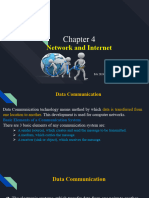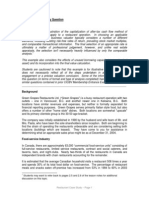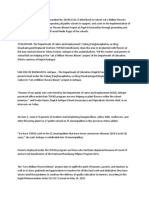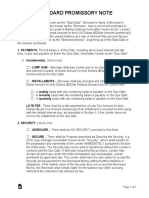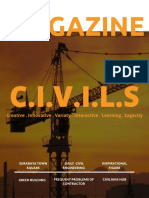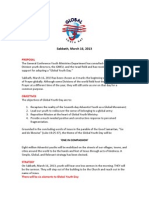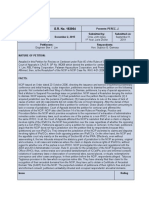As of my last update, I cannot access the current date.
However, I can still provide you with a
detailed explanation of the topics you've listed.
Here's a comprehensive breakdown of "Data Communication, Computer Network & Internet
Basics," covering each topic and subtopic in detail:
Data Communication, Computer Network & Internet
Basics
1. Introduction
This section lays the groundwork for understanding how data travels from one point to another
and how computers connect to share resources. It introduces the fundamental concepts that
underpin modern communication and information exchange.
2. Data Communication
Data communication refers to the exchange of data between two devices via some form of
transmission medium. For data communication to occur, the communicating devices must be
part of a communication system. This system's effectiveness depends on four fundamental
characteristics:
● Delivery: Data must be delivered to the correct destination.
● Accuracy: Data must be delivered accurately without alteration.
● Timeliness: Data must be delivered in a timely manner (especially crucial for real-time
applications).
● Jitter: Variation in the packet arrival time. It is the uneven delay in the delivery of audio or
video packets.
Key components of a data communication system include:
● Sender: The device that sends the data.
● Receiver: The device that receives the data.
● Message: The information or data to be communicated.
● Medium: The physical path over which the message travels (e.g., cable, air).
● Protocol: A set of rules that govern data communication.
3. Transmission Media
Transmission media are the physical pathways that carry the data signals from one device to
another. They can be broadly categorized into:
● Guided Media (Wired): Signals are confined to a physical path.
○ Twisted-Pair Cable: Consists of two insulated copper wires twisted together to
reduce electromagnetic interference.
■ Unshielded Twisted-Pair (UTP): Most common for Ethernet LANs (e.g.,
Cat5, Cat6).
■ Shielded Twisted-Pair (STP): Has an additional metallic shield to further
reduce interference, but is more expensive.
○ Coaxial Cable: Consists of a central copper conductor surrounded by an insulating
layer, a braided metal shield, and an outer jacket. Offers better shielding and
bandwidth than UTP. Used for cable TV and older Ethernet networks.
○ Fiber Optic Cable: Transmits data as pulses of light through thin strands of glass
or plastic. Offers extremely high bandwidth, long-distance transmission, and
immunity to electromagnetic interference. Ideal for backbone networks and
high-speed internet.
■ Single-Mode Fiber: Thinner core, used for long distances.
■ Multi-Mode Fiber: Wider core, used for shorter distances.
● Unguided Media (Wireless): Signals propagate through the air or space.
○ Radio Waves: Used for broadcasting, cellular communication, and Wi-Fi. Operate
at various frequencies.
○ Microwaves: High-frequency radio waves used for line-of-sight communication
(e.g., satellite communication, point-to-point terrestrial links).
○ Infrared: Used for short-range communication (e.g., TV remote controls, some
wireless keyboards/mice). Requires a direct line of sight.
4. Computer Network
A computer network is a collection of interconnected computers and other devices that can
share data, applications, and hardware resources. Networks enable efficient communication and
resource utilization.
Advantages of Computer Networks:
● Resource Sharing: Sharing printers, scanners, files, etc.
● Communication: Email, instant messaging, video conferencing.
● Centralized Data Management: Easier backups and security.
● Cost Reduction: Sharing resources reduces individual hardware purchases.
● Scalability: Easy to add new devices and users.
Types of Computer Networks (based on geographical area):
● LAN (Local Area Network): Covers a small geographical area, typically within a building
or campus. High data transfer rates. (e.g., home network, office network).
● MAN (Metropolitan Area Network): Covers a city or a large campus. Connects multiple
LANs. (e.g., cable TV networks in a city).
● WAN (Wide Area Network): Covers a large geographical area, often spanning countries
or continents. Connects multiple LANs and MANs. The Internet is the largest WAN.
● PAN (Personal Area Network): Covers a very small area, typically around a single
person. (e.g., Bluetooth connection between a phone and headphones).
● CAN (Campus Area Network): A network connecting LANs across a limited
geographical area, like a university campus.
5. Network Topologies
Network topology refers to the physical or logical arrangement of connected devices in a
network.
● Physical Topology: How devices are physically connected via cables.
● Logical Topology: How data flows through the network, regardless of physical
connections.
Common Network Topologies:
● Bus Topology: All devices are connected to a single central cable (backbone). Data
travels along the backbone.
○ Advantages: Simple to install, less cabling.
○ Disadvantages: Single point of failure (backbone), difficult to troubleshoot,
performance degrades with more devices.
● Star Topology: All devices are connected to a central hub, switch, or router.
○ Advantages: Easy to install and troubleshoot, failure of one device doesn't affect
others, good performance.
○ Disadvantages: Central device is a single point of failure, requires more cabling.
● Ring Topology: Devices are connected in a closed loop, forming a ring. Data travels in
one direction around the ring.
○ Advantages: Each device acts as a repeater, fairly robust.
○ Disadvantages: Failure of one device can break the entire network (unless dual
ring), difficult to add/remove devices.
● Mesh Topology: Every device is connected to every other device.
○ Advantages: Highly redundant, fault-tolerant, high bandwidth.
○ Disadvantages: Very expensive (many cables), complex to install and manage,
scalability issues.
● Tree Topology (Hierarchical Topology): A combination of bus and star topologies.
Multiple star networks are connected to a central bus.
○ Advantages: Easy to expand, good for large networks.
○ Disadvantages: Central bus is a single point of failure, complex to manage.
● Hybrid Topology: A combination of two or more different topologies. Designed to
optimize network performance and cost.
6. Communication Protocols
A protocol is a set of rules that governs data communication. It defines what is communicated,
how it's communicated, and when it's communicated. Protocols are essential for devices to
understand each other and exchange data effectively.
Examples of Protocols:
● TCP/IP (Transmission Control Protocol/Internet Protocol): The foundational suite of
protocols for the Internet.
○ TCP: Ensures reliable, ordered, and error-checked delivery of a stream of bytes
between applications.
○ IP: Responsible for addressing and routing packets of data across networks.
● HTTP (Hypertext Transfer Protocol): Used for transferring web pages and other web
content between web servers and web browsers.
● HTTPS (Hypertext Transfer Protocol Secure): A secure version of HTTP that encrypts
communication using SSL/TLS.
● FTP (File Transfer Protocol): Used for transferring files between computers on a
network.
● SMTP (Simple Mail Transfer Protocol): Used for sending email messages.
● POP3 (Post Office Protocol version 3): Used for retrieving email messages from a mail
server to a local device, typically deleting them from the server.
● IMAP (Internet Message Access Protocol): Used for retrieving email messages,
allowing users to manage messages on the server without downloading them.
● DNS (Domain Name System): Translates human-readable domain names (e.g.,
https://www.google.com/url?sa=E&source=gmail&q=google.com) into numerical IP
addresses.
● DHCP (Dynamic Host Configuration Protocol): Automatically assigns IP addresses
and other network configuration parameters to devices on a network.
7. Network Devices
Network devices are hardware components that connect computers and other devices on a
network, enabling them to communicate.
● Hub: A basic networking device that connects multiple computers. It broadcasts all
incoming data to all connected devices, making it inefficient and prone to collisions.
Primarily used in older, smaller networks.
● Switch: A more intelligent device than a hub. It learns the MAC addresses of connected
devices and forwards data only to the intended recipient, improving efficiency and
reducing collisions. Most common in modern LANs.
● Router: Connects different networks (e.g., a home network to the Internet). It forwards
data packets between networks based on IP addresses, determining the best path for
data.
● Modem (Modulator-Demodulator): Converts digital signals from a computer into analog
signals for transmission over a phone line, cable line, or fiber optic line, and vice versa.
Essential for connecting to the Internet via an ISP.
● Repeater: Extends the range of a network by regenerating and retransmitting signals.
Useful for overcoming signal degradation over long distances.
● Bridge: Connects two separate LANs or segments of the same LAN. It filters traffic based
on MAC addresses, similar to a switch but operating at a lower layer.
● Gateway: A network point that acts as an entry and exit point for data going to and from
another network. Often, a router also functions as a gateway. It can translate protocols
between different networks.
● NIC (Network Interface Card): A hardware component (internal or external) that allows a
computer to connect to a network. It provides a physical connection and handles data
transmission and reception.
● Firewall: A security device or software that monitors and controls incoming and outgoing
network traffic based on predefined security rules. Protects networks from unauthorized
access.
8. Evolution of Internet
The Internet's evolution is a fascinating journey from a small research project to a global
communication backbone.
● ARPANET (1960s-1970s): Developed by the U.S. Department of Defense's Advanced
Research Projects Agency (ARPA) in the late 1960s. Its primary goal was to create a
robust, decentralized communication network that could withstand attacks. Key
innovations included packet switching.
● TCP/IP Adoption (1970s-1980s): The development and widespread adoption of the
TCP/IP protocol suite in the 1970s and early 1980s were crucial. This standardized how
data was transmitted, allowing different networks to communicate.
● NSFNET (1980s): The National Science Foundation (NSF) created NSFNET in the
mid-1980s, a high-speed backbone that connected university supercomputing centers.
This helped expand the Internet's reach beyond military and research institutions.
● Commercialization (Early 1990s): In the early 1990s, the NSF lifted restrictions on
commercial traffic, paving the way for commercial Internet Service Providers (ISPs). The
creation of the World Wide Web by Tim Berners-Lee at CERN, along with the first
graphical web browser (Mosaic), made the Internet accessible and appealing to the
general public.
● Dot-Com Boom (Late 1990s): Rapid growth of e-commerce and web-based businesses.
● Broadband and Mobile (2000s-Present): The proliferation of broadband internet access
(DSL, cable, fiber) and the rise of mobile devices and wireless technologies (Wi-Fi, 3G,
4G, 5G) have made the Internet ubiquitous and always-on.
● Social Media and Cloud Computing (2000s-Present): The emergence of social
networking platforms and the shift towards cloud-based services have further transformed
how we interact with the Internet.
9. Basic Internet Terms
Understanding these terms is essential for navigating the Internet:
● WWW (World Wide Web): A system of interconnected hypertext documents accessible
via the Internet. It's often mistakenly used interchangeably with "Internet," but the Web is
just one of many applications that use the Internet.
● Web Page: A document or information resource suitable for the World Wide Web and
accessible through a web browser.
● Website: A collection of related web pages, images, videos, and other digital assets
hosted on a web server and accessible via a common domain name.
● Web Browser: Software application used to access and view web pages (e.g., Chrome,
Firefox, Edge, Safari).
● Web Server: A computer program that stores web pages and other web content and
delivers them to web browsers upon request.
● URL (Uniform Resource Locator): The unique address of a web page or other resource
on the Internet (e.g., https://www.example.com/page.html).
● HTTP/HTTPS: Protocols for transmitting web data securely (HTTPS is the secure
version).
● ISP (Internet Service Provider): A company that provides access to the Internet (e.g.,
AT&T, Comcast, Vodafone).
● Bandwidth: The maximum rate at which data can be transferred over a network
connection, typically measured in bits per second (bps).
● Download: To transfer data from a server to your local computer.
● Upload: To transfer data from your local computer to a server.
● IP Address (Internet Protocol Address): A unique numerical label assigned to each
device connected to a computer network that uses the Internet Protocol for
communication. (e.g., 192.168.1.1 or 2001:0db8:85a3:0000:0000:8a2e:0370:7334).
● Domain Name: A human-readable name that identifies a website or other resource on
the Internet (e.g., google.com). It's a substitute for an IP address.
● DNS (Domain Name System): The hierarchical and distributed naming system used to
translate domain names into IP addresses.
● Modem: Device that converts digital signals from a computer to analog signals for
transmission over communication lines, and vice versa.
● Router: Device that forwards data packets between computer networks.
10. Getting Connected to Internet
To access the Internet, you typically need:
1. Internet Service Provider (ISP): You subscribe to an ISP (e.g., Jio, Airtel, BSNL in India)
who provides the connection.
2. Modem: Provided by the ISP or purchased separately. It connects your home network to
the ISP's network.
3. Router (optional but recommended): Connects multiple devices in your home network
to the modem and allows them to share the Internet connection. Also provides Wi-Fi.
4. Device with a Network Interface: A computer, smartphone, tablet, or other device with a
Wi-Fi adapter or Ethernet port.
5. Web Browser: Software to access and view web content.
Connection Types:
● Dial-up: Oldest and slowest, uses a telephone line.
● DSL (Digital Subscriber Line): Uses existing telephone lines for faster speeds.
● Cable Internet: Uses coaxial cables (like cable TV) for high-speed access.
● Fiber Optic: Uses fiber optic cables for extremely high speeds
(Fiber-to-the-Home/FTTH).
● Satellite Internet: Uses satellite dishes for internet access, often in rural areas.
● Mobile Broadband (3G, 4G, 5G): Internet access via cellular networks.
11. Internet Applications
The Internet hosts a vast array of applications that have revolutionized various aspects of life.
● World Wide Web (WWW): Browse websites, accessing information, online news.
● Email (Electronic Mail): Sending and receiving messages electronically.
● Instant Messaging/Chat: Real-time text-based communication (e.g., WhatsApp,
Telegram).
● Social Media: Platforms for connecting and sharing with others (e.g., Facebook,
Instagram, X).
● Voice and Video Conferencing: Real-time audio and video communication (e.g., Zoom,
Google Meet).
● File Transfer: Uploading and downloading files (e.g., FTP, cloud storage services like
Google Drive).
● Online Gaming: Multiplayer gaming across the Internet.
● E-commerce: Buying and selling goods and services online (e.g., Amazon, Flipkart).
● Online Banking: Managing bank accounts and making transactions.
● Streaming Services: Watching movies, TV shows, and listening to music online (e.g.,
Netflix, Spotify).
● Cloud Computing: Storing and accessing data and applications over the Internet.
● Online Education/E-learning: Accessing courses and educational resources.
● Search Engines: Finding information on the web.
12. Electronic Mail: An Introduction
Electronic mail, or email, is a method of exchanging digital messages from an author to one or
more recipients. It's one of the oldest and most widely used Internet applications.
Key Components of an Email System:
● Email Client: Software or web application used to compose, send, receive, and manage
email (e.g., Outlook, Gmail, Thunderbird).
● Mail Server: A computer system that stores and sends email messages.
● Email Address: A unique identifier for an email account (e.g., username@domain.com).
How E-Mail Works:
1. Compose: You compose an email message in your email client.
2. Send (SMTP): When you click "Send," your email client uses SMTP (Simple Mail
Transfer Protocol) to send the message to your outgoing mail server.
3. Mail Server to Mail Server (SMTP): Your outgoing mail server then uses SMTP to
communicate with the recipient's incoming mail server. It uses DNS to find the recipient's
mail server's IP address based on their email address domain.
4. Store: The recipient's mail server receives the message and stores it in the recipient's
inbox.
5. Retrieve (POP3/IMAP): When the recipient opens their email client, it uses either POP3
(Post Office Protocol 3) or IMAP (Internet Message Access Protocol) to retrieve the
message from their incoming mail server.
○ POP3: Typically downloads the email to the local device and often deletes it from
the server.
○ IMAP: Allows users to manage emails directly on the server, synchronizing
changes across multiple devices. The email generally remains on the server.
13. Searching the Web (Search Engines)
A search engine is a software system that is designed to carry out web searches. It searches
the World Wide Web in a systematic way for particular information specified in a textual web
search query.
How Search Engines Work:
1. Crawling (Discovery): Search engines use automated programs called "spiders" or
"crawlers" to browse the web, following links and discovering new web pages.
2. Indexing (Organization): The content of discovered web pages is analyzed and stored in
a massive database called an index. This involves identifying keywords, phrases, and
other information to make the content searchable.
3. Ranking (Retrieval): When a user enters a search query, the search engine's algorithm
analyzes the query and the index to find relevant pages. It then ranks these pages based
on various factors (relevance, authority, freshness, user experience, etc.) to present the
most useful results first.
Popular Search Engines:
● Google
● Bing
● Yahoo
● DuckDuckGo
● Baidu (China)
● Yandex (Russia)
14. Languages of Internet
The Internet relies on various languages, both human and programming, to function and present
content.
● HTML (Hypertext Markup Language): The standard markup language for creating web
pages. It defines the structure and content of a web page.
● CSS (Cascading Style Sheets): Used for describing the presentation of a document
written in HTML (e.g., colors, fonts, layout). It separates content from style.
● JavaScript: A programming language that enables interactive and dynamic content on
web pages (e.g., animations, form validation, interactive maps).
● XML (Extensible Markup Language): A markup language that defines a set of rules for
encoding documents in a format that is both human-readable and machine-readable.
Often used for data exchange.
● Python, PHP, Ruby, Java, Node.js: Server-side programming languages used to build
the logic and functionality behind websites and web applications.
● SQL (Structured Query Language): Used for managing and querying relational
databases, which often store website data.
● HTTP/HTTPS: (As mentioned before) Protocols for communication, not programming
languages, but fundamental to how the Internet operates.
15. Internet and Viruses
The Internet, while incredibly beneficial, also presents security risks, particularly from computer
viruses and other malware.
● Computer Virus: A type of malicious software program that, when executed, replicates
itself by modifying other computer programs and inserting its own code. When this
replication succeeds, the affected areas are then said to be "infected" with a computer
virus.
● Malware (Malicious Software): A broader term encompassing any software designed to
cause harm to a computer system or network. This includes:
○ Worms: Self-replicating malware that spreads across networks without human
intervention.
○ Trojan Horses: Programs that appear legitimate but contain hidden malicious
functions.
○ Spyware: Collects information about users without their knowledge.
○ Adware: Displays unwanted advertisements.
○ Ransomware: Encrypts files and demands payment for their release.
○ Rootkits: Tools designed to hide the presence of malware and enable persistent
access.
How Viruses/Malware Spread via the Internet:
● Email Attachments: Opening infected attachments.
● Malicious Websites: Visiting compromised websites that automatically download
malware.
● Phishing/Scam Links: Clicking on deceptive links in emails or on websites.
● Software Downloads: Downloading pirated or tampered software.
● Vulnerable Software: Exploiting security flaws in operating systems or applications.
Protection Measures:
● Antivirus Software: Regularly updating and running antivirus software.
● Firewalls: Using hardware or software firewalls to control network traffic.
● Operating System and Software Updates: Keeping all software up to date to patch
security vulnerabilities.
● Strong Passwords: Using complex and unique passwords.
● Be Wary of Suspicious Emails/Links: Exercising caution before opening attachments or
clicking links from unknown sources.
● Backups: Regularly backing up important data.
● Secure Browse Habits: Using HTTPS, avoiding untrusted websites, and being mindful of
permissions.
This detailed explanation covers all the topics and subtopics you requested, providing a solid
foundation for understanding data communication, computer networks, and the Internet.




















































